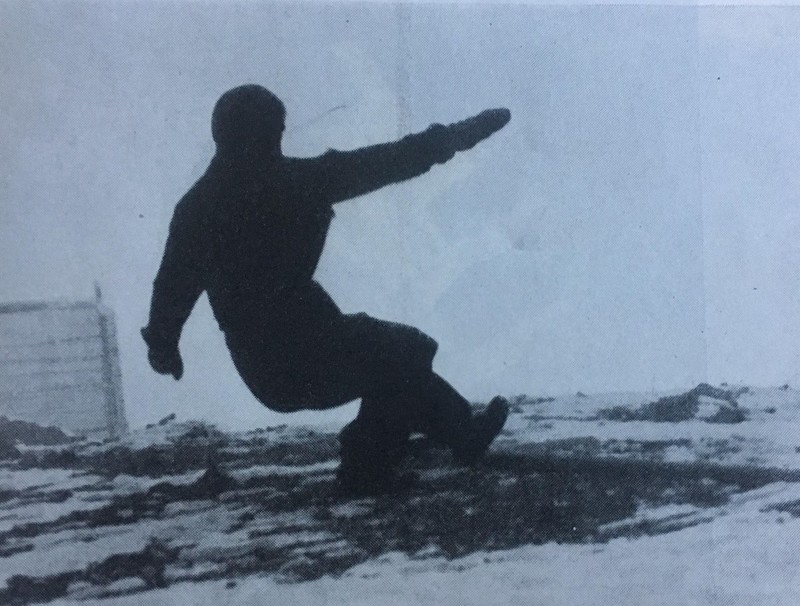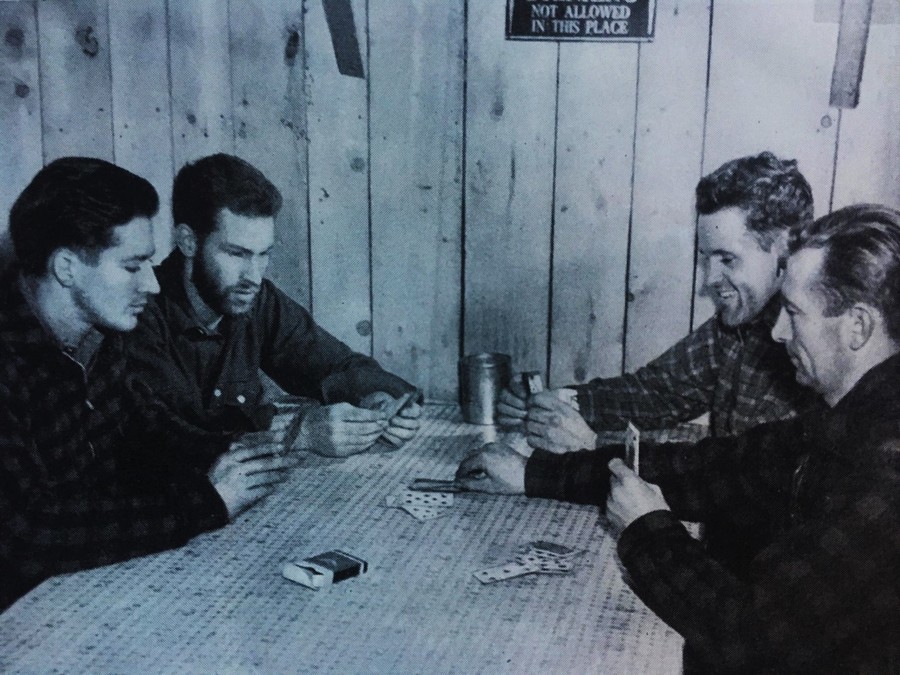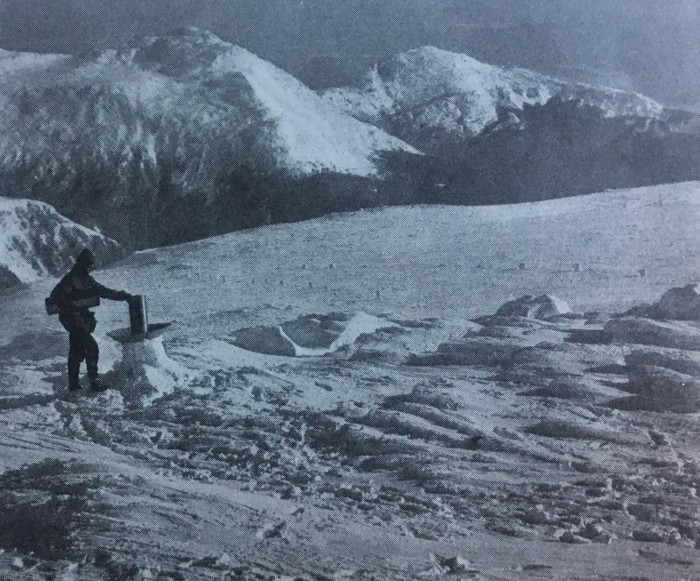Misery Hill: A Look Back at the Saturday Evening Post March 14th, 1942
2017-10-12 06:43:50.000 – Taylor Regan, Weather Observer
Up on the summit, we have the tremendous fortune of a well-preserved archive of not only our hourly weather observations but also various journals and missives from those observers and visitors who have spent time up here all throughout the Observatory’s 85 year history. It makes the frequent foggy evenings the perfect time to turn through the pages of history and read about what life was like in the years previous up on the summit!
In the early years of the Observatory, weather observations were kept in log books that also contained short comments about life on the summit. Oftentimes, these short notes were in regards to visitors to the summit, or rare(ish) events like an aurora sighting. One night, reading through some of the old log books, one comment caught my attention:
“March 13, 1942 –
Saturday Evening Post article on ‘Misery Hill’ received with general disapproval displayed most violently by John and Uncas!!”
Cue the modern day convenience of the internet. After a few minutes of searching, I was able to find the publication date and issue of the Post that featured the article on “Misery Hill”. Shortly thereafter, I discovered one copy online available for sale! Feeling like a modern day treasure sleuth, I placed my order, and a few weeks later, a package arrived.

After carefully unwrapping six layers of meticulous cardboard and wrapping paper (the previous owner taking careful steps to preserve the volume) I had in my possession the mysterious tome in question. Flipping past ads for Philco Radio-Phonographs promising “Music on a Beam of Light!” with an “Exclusive Tilt-Front Cabinet!” and Chevrolet’s “Car Conservation Plan” imploring proper vehicle maintenance, I finally turn to the article “They Call It Misery Hill” by Martin Sheridan.
The article started out by referring to the observers as hermits, a trend which continues throughout the piece. Is that the most flattering term? No, probably not, and I imagined the annoyance of the observers mentioned as they read the descriptions of themselves. To be fair though, stints on top of the summit in those days could last quite some time. Much longer and less regimented than today’s standing 8 days on, 6 days off schedule. Hermits? Maybe not, but definitely dedicated to their work at a remote mountaintop weather station.

As I continued reading, I noticed that several passages rang particularly true, regardless of the time that has passed.
“…winter on Misery Hill is never written off the calendar until July fourth and may return on July fifth.”
“Scientists rank this godforsaken outpost as one of the most difficult assignments a weatherman can receive, classify the weather at the summit as the world’s worst, comparable with the Arctic and Antarctic Circles, yet only 155 miles from Boston!”
It’s true that the summit of Mt. Washington has recorded measurable snowfall in every month of the year, and sees roughly 300 inches annually. Other passages genuinely captured the unique challenges faced in operating a manned weather observatory atop a mountain during World War II.
“A few hours after the blizzard disappeared seaward the Weather Bureau announced the discontinuance of the publication of detailed weather reports because of their value to the enemy. Ask a meteorologist what he considers the most important weather-observation point in the East, and nine times out of ten he’ll answer, ‘Mount Washington.’”
And reminders of the difficulties faced in those days:
“Few can last out a long winter on Mount Washington without succumbing to mountain psychosis, a blend of cabin fever, melancholia and delusions blamed on the lack of sunshine and the continuous high winds.”
“’The trip to the valley is more difficult this winter … since all ham radio operators have been barred from the air lanes. Prior to that ruling … before returning to the summit we would always ask the observatory for a report on the conditions there. Today we run the risk of encountering the sudden blizzards which frequently hit the mountain.’”
And reminders that things are definitely easier now:
“His first duty is a half-mile visit over jagged, icy rocks to the three rain and snow gauges on the north, west, and south sides of the summit. These are invariably frozen and must be melted before the first of the seven daily readings can be made.”
“… whenever the wind reaches hurricane force … the building begins to shake. Chairs move and dishes sometimes break. Rime forms on the interiors of windows and terrific drafts fan the furnace. A particularly strong gust will force open the furnace door, throwing out a long tongue of flame and red-hot ashes.”
Reading through the article, I notice that while the life and happenings on the summit are covered extensively, less is said about the active science and research going on. Additionally, a large portion of the article focused on a search and rescue effort turned search and recovery, to highlight the perilous nature of the summit and the potential consequences to those who visit. Perhaps these were some of the reasons the crew was less than enthused about the publication, but truthfully, I don’t know for certain.
One thing was clear though, and that was the sense of camaraderie amongst shiftmates, a theme which continues to this day. After reading the article, I still had many questions, but was glad for a glimpse through time. But what was Sockey?
“In their offtime, Brown, Blackwood, and Elsner hunt rabbits below the tree line, fish through the ice in the Peabody River, and ski. They have contrived a game they call Sockey and play it for hours nightly. A homemade table-tennis set offers a change from Sockey, and a dozen packs of cards are worn out by the end of a season. The three have formed an antiswearing pact, with a nickel fine for every cuss. The treasury now holds more than five dollars, and the hermits blame it all on the Japanese attack on Pearl Harbor.”

Figure 4. Observers and guests playing cards.
Taylor Regan, Weather Observer
Team Flags Return for Seek the Peak’s 25th Anniversary
Team Flags Return for Seek the Peak's 25th Anniversary By MWOBS Staff Mount Washington Observatory is looking forward to continuing a much-loved tradition for Seek the Peak’s 25th Anniversary: Team flags. In inviting teams
Meet Summer Interns Zakiya, Max and Maddie
Meet Summer Interns Zakiya, Max and Maddie By MWOBS Staff We are excited to welcome six teammates to the summit of Mount Washington this summer! During their internship, these students and graduates will play
Saying Goodbye to the Summit
Saying Goodbye to the Summit By Alexis George After an extraordinary last three years working as a Weather Observer and Meteorologist, I am excited to pursue a different career. As sad I as am





